When a person selects new household equipment for his kitchen, sales consultants invariably try to offer models: innovative, with great functionality, expensive. Such functions of the stove are considered practically necessary, but is this really so? It’s worth taking a closer look at what oven convection is and why it’s needed. And is it necessary at all?
The water is heated and gradually turns into steam before being sent to the oven. This steam system prevents any burning of food. This type of cooking mode creates a little noise. However, the steam causes condensation on the panel oven, making it difficult to perceive the state of food in the room.
Its biggest advantage is that it allows you to cook on multiple levels at the same time, so you can cook chicken and pie at the same time. If you are single or a couple without children, if your kitchen is narrow, choose a mini oven or microwave. For families, you should find your happiness with an oven for preparing important dishes. Choose a traditional oven or stovetop.
Gas convection oven: conventional oven design
How does the oven work? If the kitchen area is regular stove old model, then in her oven everything is arranged quite simply: at the bottom there are 1 or 2 burners, above which it is possible to install shelves with baking sheets at different heights. Gas element It heats exclusively from below, the top of the baked dish is browned, according to physics, by natural convection. Convection refers to the movement of hot air accompanied by heat exchange.
They are dusty, they are collected with a soft brush, but be careful, catalysis has only one enemy: sugar, but if you do not resist the pleasure of sweet and caramelized dishes, if there is a splash of sugar, clean, while it is lukewarm with a damp cloth.
Pyrolysis oven: self-cleaning!
Hop, you start the pyrolysis program and go! In addition, the enhanced insulation system, especially for safety reasons, ensures less heat loss during cooking. The result is we save energy!
Pyro-control furnace: high technology
Classic oven: manual cleaning. It exists in a mechanical or electronic version and has all cooking modes.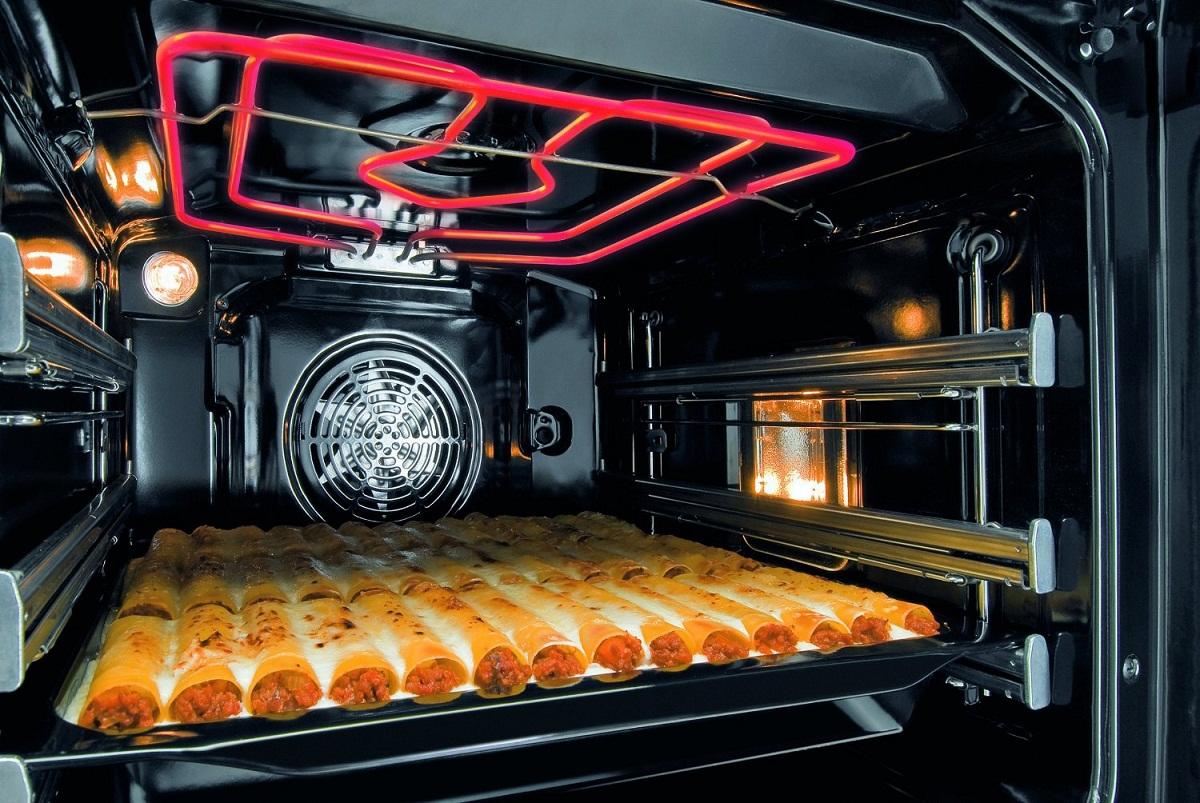
In such an oven, it is not uncommon during cooking for something like this to happen: on the one hand, at the back wall, the dish has already browned and is even starting to burn, while the one located close to the door has not even thought of getting crusted yet.
You need to take out a baking sheet or mold during cooking and turn them over so that the dish is cooked equally on all sides. But, it must be said, not all types of dough are comfortable with such rotations. For example, a biscuit product may well fall off, but there is nothing to say about meringue - it requires a very careful baking regime so that the most delicate foam does not settle. A more modern gas oven may also have an upper heating element in the oven - a burner. The burner can be electric on top and gas on the bottom.
Oven Cleaning: Smart User Guide
First, choose a product that fits the surface of your device to prevent damage. Use it in a ventilated place away from any flame, cigarette or heat source. After cleaning, rinse the surface thoroughly with a sponge to avoid unpleasant odor when using the oven next time. Inside self-cleaning ovens electric stoves ceramic slabs with finishing Teflon aluminum accessories painted or varnished surfaces porous or brittle coatings microwaves. In addition to allowing meat and fish to cook gently and deliciously, the lid prevents fat from splattering on the oven walls. Same principle with terracotta wraps and casseroles, which also allow you to cook without fat! Protect your broiler pan with parchment paper when baking French fries, cookies, and croques. When grilling, add a little water to the pan so any fat that drips off doesn't cook!
- Bring gloves and apply the product.
- Accept the kitchen cast iron pan, even in the oven!
The presence of an additional heat source makes the cooking process:
- Easier;
- Better quality;
- Faster.
The housewife can, if necessary, regulate the heat in the oven from above and below with her own hands and prepare grilled dishes. It is convenient to use an electric oven, since modern models, for example, Electrolux (Electrolux) heating elements more than one. But even this is not able to ensure complete, uniform baking of dishes that are cooked in an electric stove. This happens because natural convection in household oven is slow and depends on other factors. For example, the width of the baking sheet that is placed in the oven - if there are no gaps on the sides, the electric stove does not spread heat from the bottom upward. The bottom of the baked goods is doomed to burn, and the top will not bake. And then it is necessary to use forced convection. This is precisely the mode that consultants who sell household equipment so praise when they offer to purchase Bosch electric oven(Bosch), Hephaestus, Ariston or Samsung.
There are several models for everyone: from a simple and traditional oven, if you are cooking a small, high-quality oven with professional accessories such as a meat umbrella. They all differ in their method of care and cooking, but also in their design and color.
Before you think about the contents of the oven, you need to choose a cooking method. The most suitable cooking mode for everyone is the multifunctional rotating heat to heat food at the same time different types on several levels, all with uniform cooking. Some ovens are completely autonomous: equipped with automatic functions, they control the cooking themselves, simply by selecting the type of food you have installed on the hob.
Forced convection mode in the oven: what is it?
Convector in in this case means mode forced circulation air in the oven. The movement of hot air is provided by the ventilation element. In the closed space of the oven there is a real hot air blowing system.
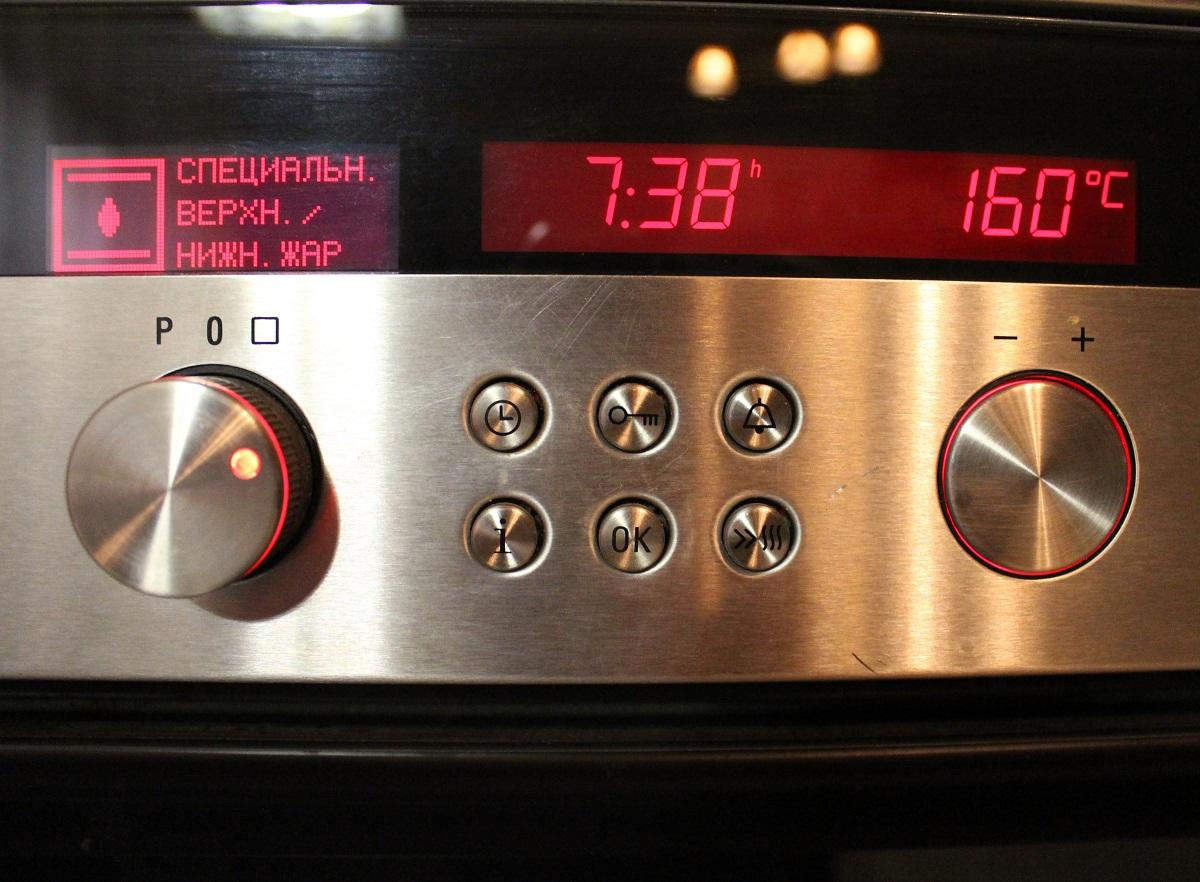
If you have the ability to cook like a great chef, choose accessories previously reserved for kitchen professionals who come to the public, such as a meat probe or steamer. In order to cook food as efficiently as possible, many innovations have emerged, offering more practical and convenient ovens. By allowing you to prepare food faster, it saves you time preparing your dinners.
Another innovation is a furnace with a separator. The latter divides the oven into two independent ovens. So you can use only the bottom part or only top part or both at the same time different temperatures And at different times preparations. Obviously, the oven is also used as a regular oven, this is enough to remove the separator.
Convective heating while a dish is being cooked in the oven heats it up equally on all sides, therefore:
- Nothing burns from the bottom;
- A magnificent crispy crust forms on top;
- The dish will be completely cooked.
A forced convection system is usually located on back wall ovens. The fan can be turned on separately and prepare properly delicious baked dishes. After the end of cooking, the timer usually beeps, giving a signal.
Designation of oven modes
There are several ways to clean a furnace: pyrolysis, hydrolysis and catalysis. Cleaning by pyrolysis is carried out automatically. All contamination is eliminated by increasing the oven temperature to 500 degrees. On average, pyrolysis lasts from 75 to 120 minutes, depending on the condition of the furnace. Once the process is complete, all you need to do is clean off the fine residual ash with a cloth.
Cleaning by hydrolysis is faster and less thorough. To do this, pour a certain amount of water and a few drops of washing liquid onto the oven floor, and then program the hydrolysis. When cleaning is complete, dirt can be removed with a sponge or cloth. Economic and environmental, hydrolysis occurs faster.
Convection in the oven: what is it for?
The conventional operating mode makes it possible to successfully cook large pieces of meat, bake delicious pies, make the most delicate meringues, and even just dry herbs, citrus zest or crackers. You can even do without heating; a cold convection system can handle drying quite well. Low heating with convection makes it possible to quickly defrost meat products or vegetables from the freezer. Turned on convection will allow you to use the entire volume of the oven to the maximum efficiency: even if the housewife places 2 or 3 baking sheets inside, everything will bake evenly, and the product will not burn. This does not mean that the function should be turned on every time you cook food.
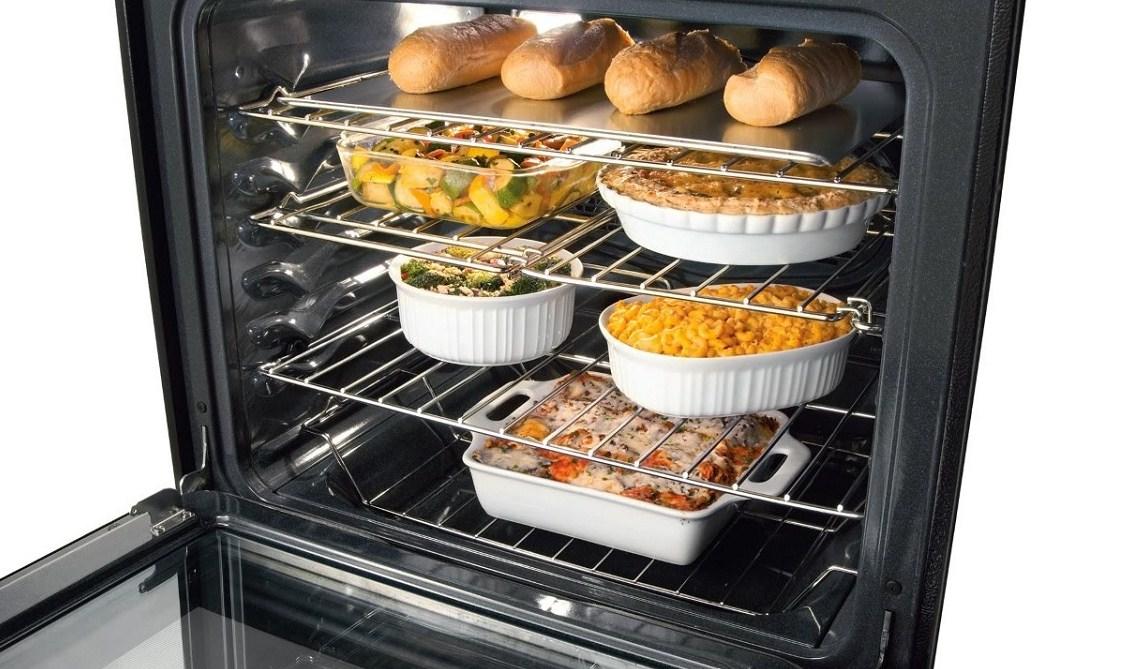
You need to turn on the ventilation system when it is really needed.:
- You need a grill with a crispy crust;
- It is necessary to dry up a lot of juice that has been released;
- It is necessary to bake a large pie or game well.
Why should application be preferred? Yes, all because the dishes turn out the way they were planned, they won’t burn, they’ll be perfectly baked, and they’ll have a beautiful exterior and interior appearance.
What is convection: types
Typically, an electric oven has a simple convection fan, the function of which is simply to circulate air through the volume. The most efficient fan is one that is surrounded by an additional heater (heater). In a number of models electric stoves Miele brand has an excellent wet convection function. When the function is turned on, the air masses inside the oven are saturated with steam. Dishes do not dry out, they absorb the right water, it is possible to steam whatever you want without harmful frying. In Neff brand ovens, manufacturers install reinforced fan systems that create a strong flow of hot air.
Rapid heating gives very good results:
- The product quickly becomes covered with a fragrant crust;
- With further baking, the juices do not evaporate;
- The dish is completely baked.
Everything said above applies to electric ovens. In the usual gas oven there was no forced convection mode before. However, not so long ago the Electrolux brand released a new product to the market: now gas stove can be equipped with a fan to create forced convection.
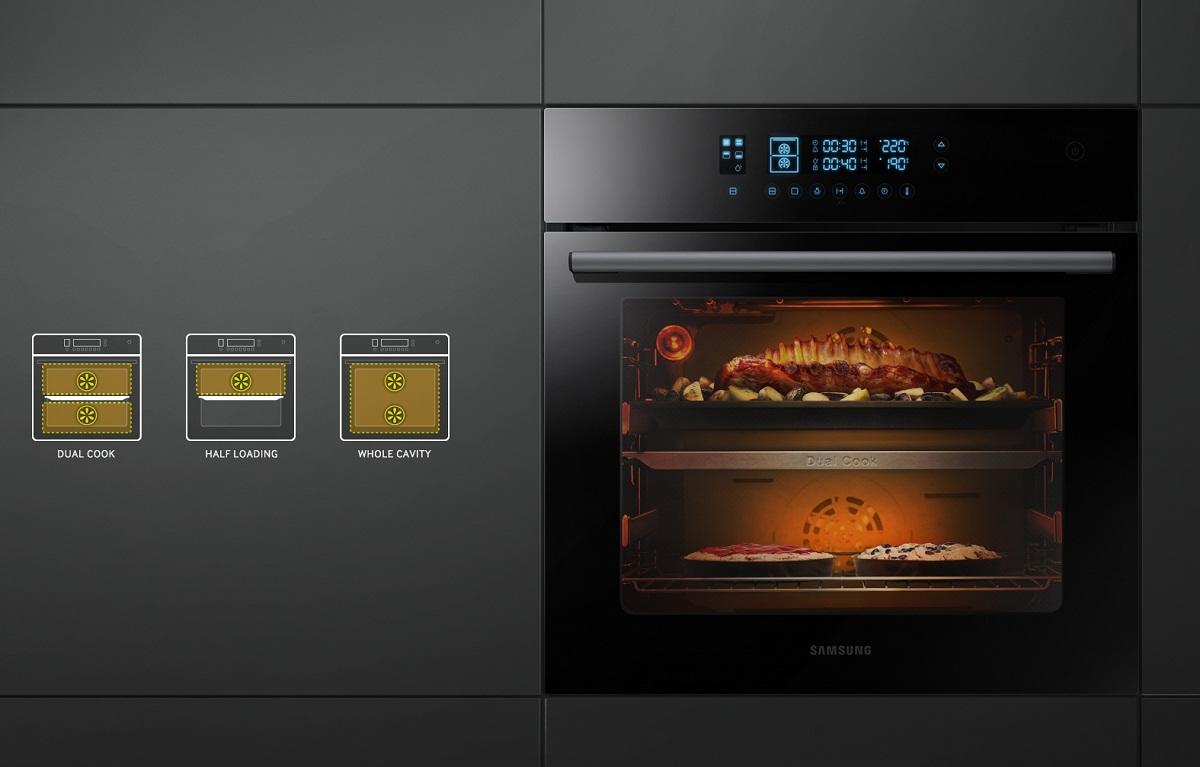
So far, only a stand-alone stove has this function, but it is not a fact that manufacturers will not create innovative models.
A gas stove is still more popular today than an electric one, at least when it comes to ovens that stand separately. The domestic market was no exception. Gas in Russia is still not more expensive than electricity. Therefore, a gas oven from Gorenje, Hansa or another brand is installed in 80 out of 100 homes. Today, those who prefer gas oven, will be able to buy a model with convection.
Oven modes: designations
Typically modes are indicated using a specific icon. Despite a number of differences, these icons are always similar and mean the same operating modes of the oven.
The decoding of the designation may be as follows:
- Bulb. Oven lighting – the light inside turns on regardless of the selected cooking mode.
- Double horizontal line. Static oven - standard convection cooking.
- Fan and horizontal stripe underneath it. Functions only bottom heating atelier.
- Three triangles on top. The grill is working.
- The same triangles, but with a fan. There is a variable grill and a turbo grill with convection.
- Fan in a circle. Hot fan – cooking with hot air distributed by a fan system.
- Fan between 2 horizontal lines . Convection cooking with a fan; heaters operate at the top and bottom of the oven (heating element).
- Fan in a circle and a horizontal stripe at the bottom. Defrosting and heating – the ring convector and the bottom heater function simultaneously.
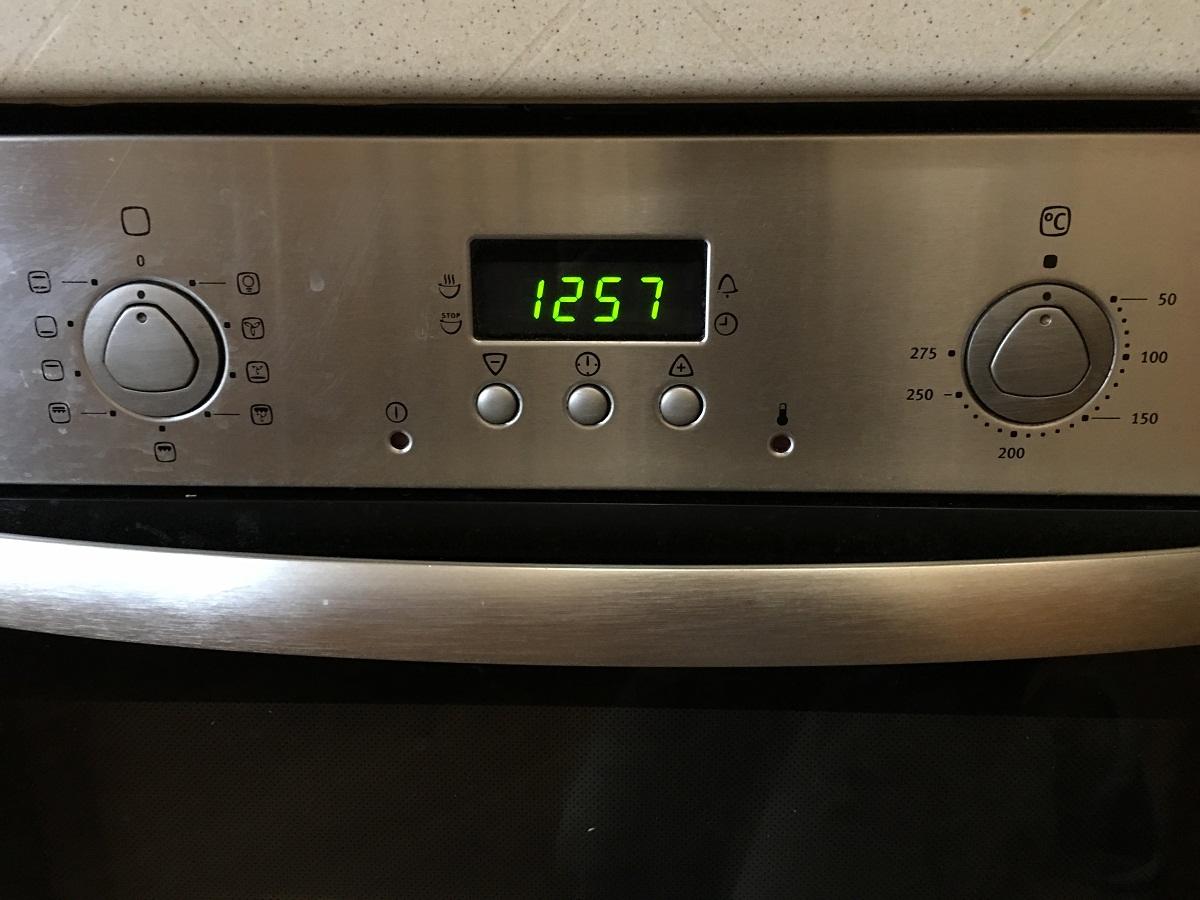
The decoding looks quite simple. The stove is always accompanied by instructions where the signs are described in detail. The symbols help the housewife to cook correctly. A good oven must have a temperature gauge.
What is convection in an electric oven and its advantages
A mode such as convection in the oven, as has already become clear, is very convenient and has many advantages.
With it you can:
- Bake large pieces of meat, fish, and poultry, which must be baked evenly on each side.
- Bake evenly large groceries that span the entire baking sheet, such as large pies, pizza, etc.
- Make a beautiful, aromatic fried crust on baked goods, meat, fish, vegetable and fruit dishes.
- Perform gentle baking different types confectionery products, for example, cakes, meringues, delicate biscuits, etc.
- Dry vegetables, fruits, herbs.
- The slight heating of the convection oven makes it possible to quickly defrost meat and frozen vegetables and fruits.
- Cook on 2-3 baking sheets at the same time, without fear that the dishes will not be baked.
The above oven capabilities make it clear why convection is needed. If the housewife likes to cook a variety of dishes, then she will be able to fully appreciate these advantages. Convection, as already mentioned, may not be used every time a new dish is prepared.
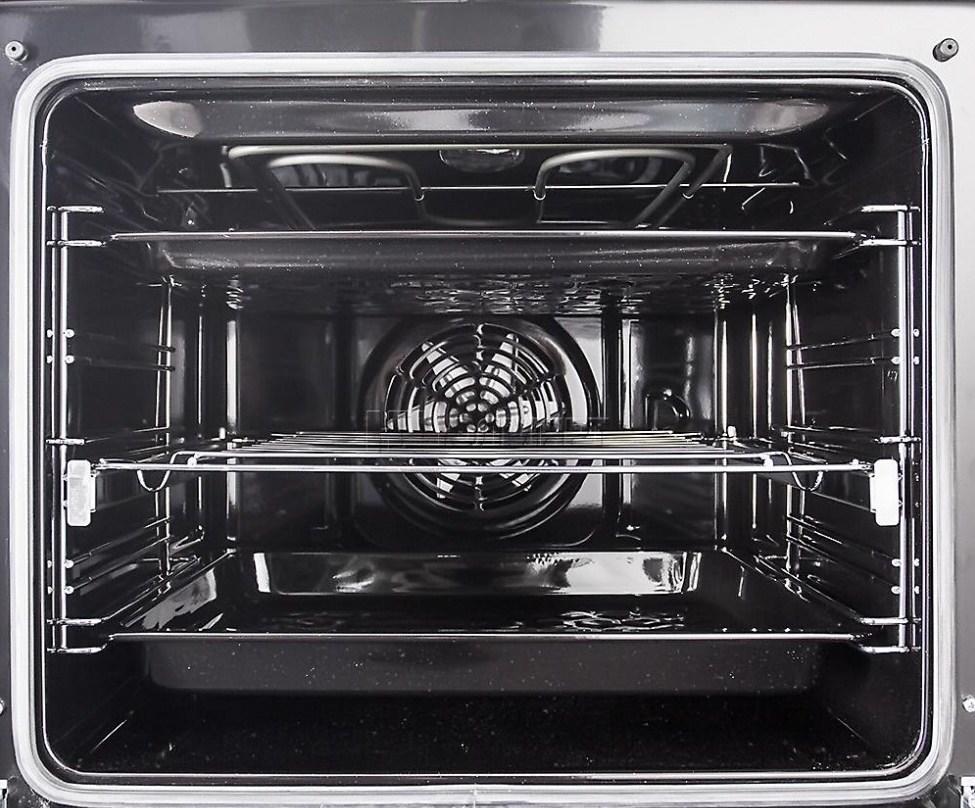
You can use this mode for baking certain foods or when you need it for defrosting.
Convection modes in the oven are always turned on separately. The function can have different convection modes. There may be several of them. The presence of convection is indicated by an icon that is present on the control panel. You can read about the purpose of special symbols in the instructions for a particular oven.
Convection can be present in the oven in combination with grilling, and can also be turned on with the lower and upper heaters at the same time. The frying mode can also be switched on separately. It can operate in turbo mode, providing enhanced heating of the entire space in the oven, if such a function is provided by the oven manufacturer. In modern models there may be ECO function, which is intended for cooking food using a small amount of electricity. Also very convenient is the “Pizza” function, which makes it possible to evenly bake dishes that have a complex composition.
Convection mode in the oven: what is it (video)
A function such as convection, used in ovens, is very convenient and beneficial to housewives. It allows you to significantly expand the range of prepared dishes, and also significantly improves the quality of baked food. When choosing a suitable oven for yourself, you need to make sure that this mode is present in it. If the oven is equipped with convection, then both men and women, even without special culinary abilities, will be able to prepare delicious delicacies for themselves and loved ones. By the way, you can buy such ovens at shopping centers Ikea or Pyramid.
Communicate with ovens in one language:
Mode 1: bottom + top heating,
Mode 2: Bottom Intensive Heat + Top Heat,
Mode 3: bottom heat + top heat + fan,
Mode 5: bottom heating + fan,
Mode 6: top heating,
Mode 7: top heating + fan,
Mode 8: ring heater + fan,
Mode 9: ring heater + fan + bottom heating,
Mode 10: ring heater + fan + bottom + top heat, special modes, grill,
Mode 11: grill + top heat, Mode 12: grill + fan, the dough will not run away, the pies will not burn
A modern electric oven is a rather interesting device; it can do a lot, and can sometimes confuse an inexperienced buyer: why are there so many modes, how do they differ from each other, and, most importantly, are they needed? That’s why we decided to take a closer look at these very modes, to understand the logic of their impact on products, so that anyone who reads this article can firmly decide what they need and what they don’t.
Text: Olga Kuzmina
Tips: Andrey Rydzevsky, chef at Electrolux
Communicate with ovens in the same language
When a housewife gets acquainted with a new oven, the first thing she encounters is the need for translation. And not in the sense from one language to another, but more often from the names inherent in each company to generally accepted terms.
What is it for? It's simple, you can compare one oven with another only when the object of comparison is clear. Therefore, we avoid pretentious, and most importantly, incomprehensible expressions such as “turbo air”, “maxi-grill”, “intense hot air”, “thermal circulation” or “3-0 convection”. And if the description includes any function like “slow baking” or “gratin”, we strive to “shake” the whole truth from the brand department about how it works.
That's why specifications in manufacturers' catalogs they look much brighter and more seductive than our boring, but understandable data. We will not deviate from this rule now, so we assign the same names to the modes that you will see on the following pages of the review.
Don't forget to reheat
At the beginning of the story there are several general advice. In the instructions for ovens (which we actively use), for successful cooking, it is recommended to preheat them to the required temperature (we focus on the thermostat indicator lamp; it should go out).
Only for very fatty meat can you make an exception and put it in a cold oven. In this case, the cabinet can be turned off a few minutes before it is ready; the residual temperature will be sufficient for the successful completion of the process. It is advisable to open the door as little as possible, and observe the “behavior” of the products through the glass (this is why the backlight often does not turn off while cooking is in progress).
Mode 1: Bottom + Top Heat
This is a mandatory mode for any electric oven. It has many names: static, traditional, classic heating. Two heating elements below and above are turned on simultaneously. The heat generated by the elements creates the effect of natural convection: a hot flow rises from below, and a cool flow falls from above. But this movement is not as rapid as we would like, the process proceeds slowly, and heat does not always fill the oven chamber evenly. The lower heating element is always more powerful.
Some foods, particularly pies, are more difficult to bake from the bottom. While browning on top is not a problem. The position of the baking sheet in the oven allows in this case to achieve balance. Good example- pizza. To make it crunchy from below, the baking sheet with the pie is placed on the lower levels, otherwise the dough will not bake and the filling on top may burn.
Conclusion: You can use the guides in the middle of the oven. But, if you want the heat to flow more strongly from above or below, the grille is moved one floor in the desired direction.
We obtained a variety of dishes suitable for cooking in this mode from catalogs and instructions:
- These are savory pastries, muffins, cookies, tender cakes, biscuits, bread;
— Stuffed vegetables;
— Lasagna;
— Roast, pork ribs, lean beef, poultry;
- Fish, fish casseroles.
Mode 2: Bottom Intensive Heat + Top Heat
This is a variation of the traditional mode, here a more powerful lower element is installed than usual. Turn on this mode if you want to quickly fry the dish from below. In addition, it is suitable for forms that do not conduct heat well, such as glass and aluminum vessels.
Andrey Rydzevsky, chef Electrolux professional
I prefer this mode for dishes in pots, so-called Casserole. The presence of liquid will prevent the roast from burning, and the dish will cook faster, since there is good heat from below and from above - as a result, the pot simmers evenly on all sides.
Mode3: bottom heat + top heat + fan
Two heating elements work, but they are also connected to a fan installed on the rear wall. When the turbine rotates, streams of hot air rapidly spread throughout the oven. This creates the same climatic conditions throughout the entire volume, which means a uniform effect on the products. It is preferable to choose a medium level of guides in order to take full advantage of circulation and an even microclimate in the oven.
It is very important that heating of dishes due to the movement of air masses becomes more intense, the set temperature is reached in a very
In a short time, the food browns faster and on all sides. The speed of the process allows you to preserve the internal juiciness of the dish. In this mode, it is possible, and sometimes necessary, to reduce the usual temperature. In addition, cooking will take much less time; according to some data, the cycle time can be reduced by 30%.
In the vocabulary typical for describing ovens, the operation of a fan can be called convection. This is quite acceptable, although, strictly speaking, in the traditional mode there is also convection. Let's clarify.
Convection is the phenomenon of heat transfer, in our case, in the air. Natural convection occurs when a volume of air is heated unevenly, warmer is lighter, colder is heavier. But the fan creates forced convection, that is, the mixing of flows depends not on temperatures, but on the speed of rotation of the blades. In our magazine, a fan may be called a convector, but the word convection is not used as the name of this mode.
Ovens equipped with a fan (or a ring element with a fan) are called multifunctional. If these devices are not available, the model is static.
The mode is suitable for large dishes that require even cooking inside and out, for example, fried rolls, pork trotters, cakes, puddings, casseroles, roasts.
Some manufacturers specify that you can cook on 2 levels at the same time.
Andrey Rydzevsky, chef Electrolux professional
Dual heating mode with fan is good for large pieces of meat, fish and whole poultry. This mode is also suitable for large dishes that require even cooking inside and out, such as roast rolls, pork trotters, cakes, puddings, casseroles, roasts.
On the other hand, some dishes, for example, meringues and omelettes, do not like convection, so static is preferable for them.
Mode 4: Bottom Heat
The lower heating element is the most “secret” element of the oven; it is not visible, it is hidden behind the bottom of the chamber. Heating from below is often the main factor in very simple ovens, in more complex ones it rather serves as an auxiliary one. It is recommended to use it for drying the bottom of pies with a wet filling, for example, fruit, browning on the bottom, and for canning. Bottom heat is also chosen for long-term baking.
The mode has significant disadvantages - longer cooking compared to the two options already described. The housewife is forced to pay more attention to the process itself: unfolding the baking sheet, moving it lower or higher.
Mode 5: Bottom Heat + Fan
The principle of this mode is the same as when the lower element is working, only cooking proceeds more quickly. The heat from below rises to the ceiling, is captured by the currents created by the fan and spreads throughout the oven. This mode is often recommended for baking open-faced cakes or quickly finishing baking when required. heat from below, e.g. for low-rising baked goods yeast dough. Pros: juicy inside and evenly browned on all sides, especially the bottom. The instructions for the Gorenje oven do not advise using tall forms so as not to disturb the circulation of heated air over the dish.
Mode 6: Top Heat
The upper heating element is located along the perimeter of the oven ceiling; this tube is always visible. In this mode, the element works solo. The heating is not so intense and, in addition, natural convection is difficult. The mode is chosen for frying almost finished dishes on top, for example, cakes, casseroles, browning breading, as well as cooking lightly fried vegetables on the grill. In the instructions for the Ardo device we found the following dishes: dumplings, polenta, rice, lasagna, pasta casseroles, vegetables with bechamel. And Miele has puddings and baked vegetables.
Andrey Rydzevsky, chef at Electrolux professional:
Andrei Rydzevsky chooses this mode for “juliennes, French-style meat and all dishes that require giving them a golden “cap” of cheese and mayonnaise.” We cook only on the upper tier of the guides.
Mode 7: top heat + fan
This is an accelerated “version” of the previous mode 6. The combination of heating and the movement of air masses allows you to achieve a light golden crust on the surface of products with uniform internal heating. Therefore, the mode is chosen for dishes baked in molds: casseroles, soufflés of vegetables, meat, lasagna.
Andrey Rydzevsky, chef of Electrolux professional: - Sometimes the difference between some modes is very speculative, that is, we are not dealing with technical, but rather with marketing categories.
Regarding the use of some modes, I have my own opinion, different from what is usually written in the instructions. It is based on my daily experience. I think housewives will also quickly be able to master the intricacies of their new ovens and adjust their capabilities to suit themselves.
Mode 8: ring heater + fan
A spiral heater is placed on the back wall of the oven, folded into a ring, and inside this ring there is a fan. The circular shape was not chosen by chance; the warm air coming from the element is completely captured by the vortex flows created by the fan. The flows are distributed horizontally and then quickly fill the entire chamber.
It is the horizontal movement of hot air jets in this mode that allows you to cook not one, but several dishes at once, placing them on 2-3 levels of the oven. There is only one condition - the required temperature must be the same for all dishes. The drier air inside the oven and the removal of moisture prevents flavors from changing and flavors from mixing, which can result in different dishes.
The mode combines high speed and efficiency. The benefits of this achievement are especially obvious on the eve of the holidays, when you have to cook a lot.
A simple example: at one time we bake not one, but three cake layers. Some of the difficulties faced by cooks disappear; now there is no need to worry that the pie dough will overheat while the first batch is “sitting” in the oven, or that the dish baked first will hopelessly cool down while we are working on the next one.
In addition, housewives are practical people, and sometimes they simply refuse a menu with a few goodies from the oven, and with this mode the problem becomes irrelevant.
Comment from the Indesit Company press service: “This heating does not cause the dish to burn on either side; its advantages are that it is possible to maintain a low temperature, for example, for defrosting or for raising yeast dough. The regime is delicate, since infrared rays do not affect the dish."
The operation of a ring heater with a fan is suitable for puff pastry, drying herbs, mushrooms, fruits, sterilizing home canned food and all dishes that should be soft and juicy inside and at the same time well baked.
If food is being cooked on one level, then, according to Electrolux, it is wiser to use the lower guides so that the food is better visible. It is also recommended to use one level in the instructions for the Gorenje oven for juicy pastries and fruit pies. When cooking on 2 tiers, it is better to occupy the 1st and 3rd (Zanussi). As already mentioned, several baking sheets are placed in the oven at once, so it is not recommended to occupy the upper level. The instructions for Neff and Bosch ovens indicate that pies and pizza can be baked on two levels, but flat cookies and puff pastries are better on 3.
The operation of the fan increases the intensity of the impact on the products, that is, the operating temperature of the mode should be lower. It is important that you do not need to preheat the oven, although there are exceptions. Example from Miele instructions - roasting roast beef or baking dark varieties bread, and Gorenje has any baked goods. Cooking speeds up - baking takes less time. In addition, dishes are subjected to uniform temperature treatment.
In our publication, this mode is usually called convection.
Mode 9: ring heater + fan + bottom heating
EXAMPLES OF NAMES APPLICATIONS
Pizza Electrolux, Hotpoint-Ariston, Zanussi, Neff
Mode/stage for pizza Siemens, Bosch
Pizza/baked goods Kuppersbusch
Bottom heating + ventilation heating Gorenje
Gourmet AEG
Defrosting and heating De"Longhi
Convection heating + Whirlpool bottom heating
Super fast heating Gaggenau
Miele Intensive Baking
This is a combined mode that takes advantage of convection, that is, uniform and intense heat, and heating from below. But unlike the first one, only one oven level is involved here, the middle one is best. According to the recommendations of the companies, in this mode you can cook unfrozen semi-finished products, French fries, strudel (from the Neff instructions). Moreover, preheating is not necessary.
European oven manufacturers in this mode saw analogies with an oven, where heat comes from all sides, but especially from below. Such conditions turned out to be ideal for preparing pizza - an open-faced pie, which is very easy to buy in a store as a semi-finished product or to make yourself. The pizza must have well-baked and browned dough - the basis of the dish, but the filling must be warmed up, but not lose its juiciness.
In addition to pizza, the mode is selected for baked potatoes, fruit pies, cheesecake, Kirsch Laurent, pies with glaze, cheesecakes, and buns.
Several other areas of application are reheating, keeping dishes hot, defrosting.
Comment from the Indesit Company press service: “This mode is optimal for fruit pie: when we bake a fruit pie with shortcrust pastry, we need, on the one hand, that the dough is not sticky and baked well, for this we use bottom heating, but, on the other hand, the filling, i.e. upper layer, should be baked, but not burnt; for this, a ring heater and a fan work.”
Mode 10: ring heater + fan + bottom + top heating
EXAMPLES OF NAMES APPLICATIONS
Preheating Siemens
Miele Intensive Mode
Pro-hot air AEG
Multifunctional cooking Franke
Beko 3D cooking
Quick cooking Hotpoint-Ariston
This function is not common, as you can see, almost all oven heaters are used here, why is this done?
Firstly, this is a very fast achievement required temperature, so the mode is sometimes used to preheat the oven before placing a dish prepared for baking into it.
Secondly, this is quick cooking. Convection is enhanced by additional heat flows and optimal distribution temperature. The function is selected for dishes that require deep baking to form a golden brown crust.
Sometimes heaters are not used to their full potential, for example, the upper and lower heating elements use their power partially. In other cases, on the contrary, all elements work to the maximum.
Comment from the Indesit Company press service: “This mode is intended for large dishes (leg of lamb, suckling pig), which take up a lot of space in the cabinet itself, or, for example, several pans of pies, which also fill most of the space, then the temperature distribution occurs evenly at all levels."
Special Modes
FEATURES OPERATING ELEMENTS EXAMPLES
For raising yeast dough, making yogurt. Bottom heating, 40°C
38°C
35°C. Hotpoint-Ariston, Gaggenau, Whirlpool
Defrosting (40°C). Fan + ring heating. Hotpoint-Ariston
Also - heating in the environment warm air. Defrosting (30°C). Heating 40-100°C. Fan + ring heater + bottom heating. Only De"Longhi
Temperature 80°C. Fast heating (90°C). Bottom + top heating. Electrolux, Hotpoint-Ariston
Supports ready dish hot, temperature 66-100°C. Bottom + top heating. Bosch, Siemens, Candy, Hotpoint-Ariston, Whirlpool
For professional serving of food, temperature 30-65°C. Bottom + top heating. Bosch, Siemens
Grill
The grill is a tube-shaped element that is attached to the ceiling of the oven. It differs from a simple heating element, including the top one, in the specificity of its effect - with the help of infrared radiation. It heats not the air, but the food itself. The grill radiation acts strictly under the element, that is, by placing sausages or chicken legs slightly to the side, it will be difficult to achieve the desired result.
The grill can be used as the main cooking mode, as well as final stage, when you want to crisp up a dish appetizingly.
Manufacturers are unanimous in the name of this mode, only the Hotpoint-Ariston company calls it barbecue, and Gorenje calls it infraheating.
Grills come in several varieties.
The usual one is U-shaped or in the form of a zigzag, the sphere of its “interest” is the entire area of the lattice. Some models use a more economical option - a grill with two circuits, a small one inside (for example, the so-called middle part of Neff) and a large one along the perimeter of the ceiling.
The small circuit is included if the portions are small, for example, 4 pieces of toast or several thin pieces of meat. And big and small together in the case when the products are spread out over the entire grill. Grills can differ not only in area, but also in power, so it is easy to choose softer or, on the contrary, stronger frying.
Grills can operate exclusively at maximum (meaning their own temperature limit, for example, 250°C for Ardo, 200°C for Kaiser or 180°C and 220°C for Neff), but manufacturers often produce ovens with variable power to adjust the intensity of frying, say, Whirlpool has 5 power levels, or ovens with a choice of operating temperature.
The oven is preheated for 3 or 5 minutes, as recommended in the instructions from Gorenje and Ardo; Neff experts suggest preheating it for 10 minutes, but only for frying toast. The cooking level is upper or one level lower, depending on the thickness of the pieces of meat. Frying is most often done on a grate, and to prevent fat from burning and dirtying the bottom, a tray is placed on the lower level; water can be added to it to avoid smoke and fumes.
Examples of using the grill: steaks, sausages, bacon, frankfurters, kupaty, chops, liver, rolls, hearts, fish fillets, vegetables, toast, as well as dishes in small or large ramekins.








